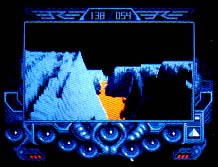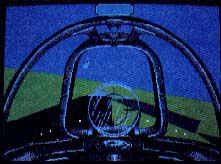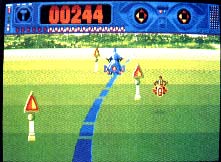For The Fun Of It
From the Forties to the Future
In this issue we look at three games that test your skill and nerve as you fight for your own survival. In Captain Blood you've been cloned and you must find all your copies before the alotted time expires. In Spitfire 40 it's you against the Germans in the Battle of Britain. And in SpaceRacer you take on the galaxy's best racers in a battle for the championship.
CAPTAIN BLOOD
reviewed by George Miller
Spectacular graphics highlighted by fractal landscapes and meticulous attention to detail make Captain Blood a one-of-a-kind game. The interesting thing about Captain Blood is that you not only get involved with the game, you actually become a part of it.
As the scenario goes, you're a cyborg who has been cloned many times over. The clones are draining your energy and if you don't find them all soon you'll die. The clones are hiding somewhere within the 32,768 planets of the vast Hydra galaxy, and you've got to find them all.
Given enough time, you could visit each planet and eventually find and disintegrate the clones in your ship's fridgitorium, but time is one thing you don't have. You have about two and a half hours of real time to find the first clone and get back some vital fluid before your arm becomes completely uncontrollable. If you do find the first clone, you've got about another two and a half hours to find the next one.
 |
In Captain Blood, from Mindscape, you're a cyborg and you've been cloned many times over. Somehow all of your copies have escaped and have hidden themselves within one of the more than 32,000 planets in the Hydra galaxy. Find them all or you die. |
Getting Started
Control gameplay from the Control Panel. Most of the options are selected by moving your mechanical hand to the appropriate buttons.
So, how do you locate the clones? Simple! Just ask. Some planets are inhabited. Many more planets are not. Fortunately, the first planet that appears always contains intelligent life. Just land and talk to the inhabitants.
Actually, it's not all that simple. You must guide your OORXX, a friendly little creature designed for reconnaissance missions to the planets of Hydra. The OORXX are your eyes and ears. Fortunately, you have an unlimited number of OORXXes available, because you'll soon discover that a fractal landscape is not an easy place to land. When you do land successfully, you'll use the UPCOM (Universal Protocol of Communication) Icon system to communicate. This unique feature lets you point at Icons to communicate with the planet's inhabitants by building sentences.
Interactive Gameplay
The various races of planets' inhabitants have various personalities to match. You'll ultimately need to interact with many different types. Sometimes logic and reason will provide a clue. Sometimes bribes or threats work best. Some will even agree to be teleported aboard your ship.
Navigate through the universe by locating your destination on your Hydra-galaxy map, then activating hyperspace to travel at approximately twice the speed of light. At this speed, you can expect to see a few optical illusions. As you approach your destination, your speed will decrease and you will be able to use your instruments to conduct a limited reconnaissance of the planet. You can then launch an OORXX to investigate further.
Recommendation
Captain Blood is both an exciting arcade action game and a challenging adventure game. No matter which type of game you prefer, you'll find something to suit your taste. The Hydra galaxy is huge. Use your best judgment as you search for your clones, and be prepared for the adventure of a lifetime!
SPITFIRE 40
reviewed by Wolf Griffey
Ever wondered what kind of exhilaration an English Spitfire pilot might have felt? Ever tried to guess what it might have been like sitting in that cockpit, with a roaring engine up front? Have you wanted to capture some of the thrill of racing across the English countryside in search of reported enemy aicraft? Is shooting down a Me-109 fighter or a group of Stuka bombers the type of action you crave?
 |
Avalon Hill's Spitfire 40 lets you live the bygone days of World War II air combat. With authentic graphics and real-time up- dating, Spitfire 40 lets you choose be- tween the Game and Simulation mode. |
If your answer is yes to any these questions, you'll like Spitfire 40 from Avalon hill. Now it's your turn to experience the sounds, speed and thrill of World War II air combat.
Piece of the Past
In 1931 the Supermarine Company won a contract from the Royal Air Force to design a new fighter plane. Based on their champion racing designs, Supermarine produced the soon-to-be-famous Spitfire. It incorporated the untried Merlin engine in the smallest airframe that could be wrapped around it.
By 1940 the Germans were staging air raids over England. The new Spitfire was being flown off of many small airfields by young and mostly inexperienced pilots. Experienced or not, however those pilots scored Victory after victory.
Spitfire 40 returns to this period and that aircraft. The player/pilot is placed at the controls of the Spitfire IA and with a choice of either Game or Simulation enters the realm of World War II air combat. The best part is that the authors put their time into making the handling and action of the simulated aircraft very realistic.
Spitfire IA
As with a real Spitfire IA, the player quickly discovers all the joys and sorrows that come from flying a true propeller-driven aircraft. The speed decays as it should in climbs and turns. Rolls and dives are also true to the nature of the beast. Used properly, these characteristics will help to maintain the position needed for the victory.
The controls, instruments and handling found in Spitfire 40 follow the lines of the actual aircraft. If it was necessary for flight in 1940, you'll find it in this game. The same characteristics are here: faster in level flight, much quicker on the turn and overall more maneuverable than its German counterparts.
Authenticity
From the beginning, Spitfire 40 has a very authentic feel. The instructions are printed in the form of a working pilot's manual from the period. Called Pilot's Notes, this "rulebook" covers important items in the following sections: Pilot's Controls and Equipment, Navigation and Handling and Flying Notes For Pilot. Here the new pilot finds out where everything is, what it does and how to use it. Each section goes into excellent detail to provide the pilot with more than a basic understanding how to fly a Spitfire.
The Pilot's Controls and Equipment section has incredibly complete instructions for aircraft control functions and their proper uses. Not only is the player told the possible reaction to activating a given item, but also what can happen if it is not used properly. Warnings appear throughout this section.
The Navigation section explains how to use the map. Since the action can take place anywhere over England, it's important to know where the bad guys are. The pilot can find the locations of his Spitfire and the target on the map at any time. Whether in Game or Simulation mode, it is most important to learn to read and use the map. Lost pilots don't find targets-- or worse, the targets find them first, which can mean a victory for the other side.
Takeoff, air maneuvers and landing instruction are found here in the section called Handling and Flying the Spitfire. Unlike some manuals that assume that you'll find the proper speeds and altitudes to complete things like rolls, loops and a split S, the notes give you the recommended control inputs and speeds to look for.
Game or Simulation
Spitfire 40 starts with two main selections, Game or Simulation. Common to both are the cockpit (controls/instrument screen and front-view screen) and map mode.
Game mode gives you time to sharpen air combat skills prior to recording actual sorties in simulated raids. Or you can just go there for the fun of destroying target after target (until you've been shot down three times.) Although there are no actual skill levels involved, as air combat time increases the skill of the enemy pilots you face will increase also.
Simulation is the heart of Spitfire 40. Here you have two options: Practice or Combat. Select practice and work with the controls until they become second nature. With propeller-driven aircraft, handling is very different from the more advanced jet fighters you may be used to in other flight simulations.
In combat you begin with a sortie message providing the number of aircraft, direction and altitude. After takeoff, it's up to you to find the incoming aircraft, score the victory and land.
Each flight is recorded in the flight log with a small entry regarding the results. Some embarrassed pilots have been known to quit before saving their logs.
In both the Game and Simulation, your goal is the same as it would have been 1940: patrol the English skies and shoot down incoming German fighters and bombers.
Well Done
The Spitfire IA was a combination of timely work and some necessary compromises. It went on to become a legend in aviation. Although Spitfire 40 may not have the full, more colorful graphics that other programs have, Spitfire 40 authors put a lot of work into the simulation. Because of just that, I think that Spitfire 40 will attain the same status as the Spitfire itself. Well done, Avalon Hill, well done.
SPACERACER
reviewed by Scot Tumlin
It's the 25th century, and neither war nor disease are to be found anywhere in the galaxy. The only excitement left is the Space Race Tournament. Every three years the best racers from each planet compete for the title of Space Racer Champ. You've been selected to represent Earth. Your honor is at stake--and so is your life. So goes the premise for SpaceRacer, the latest creation from Broderbund.
 |
SpaceRacer from Broderbund. It's the 25th century and war has been eradi- cated throughout the galaxy. Where can you go to find violence and let off a little steam? The famous Space Races, of course. |
The Space Races
In SpaceRacer, there are four races to complete: three world races and one championship race. Each race has its own course and its own challenges. The courses are rife with tight turns, fast straights, high hills and low valleys.
A power track runs along the center of each course and gives your cycle energy. Obstacles appear on each side of the course. Take a turn too wide, and watch out! Obstacles also appear on the course; some give you energy, others can ruin your day by killing you.
Riding the Cycle
With the joystick or keyboard, you can make your cycle turn, climb or dive. A quick double-press of the trigger fires the laser cannon. Hold down the trigger to move the cycle forward. Three function keys give the distance to the finish line, pause the game and invert the up/down controls.
Gameplay
As your cycle moves, a shadow is cast on the surface of the track. Keeping the shadow on the power track adds energy to your cycle. Moving off the track or climbing too high slows your cycle down. Once you learn the course, turning is a breeze and you'll be leaning with the best of them.
Signs, billboards and powerlines appear on each side of the course. Bump into a sign an you'll put your cycle in a temporary spin. Regain control and get going; remember your racing against time! Hit a billboard, and splat! --you're a pancake. Hit a powerline, and zap!--you're history.
Along the way, you'll meet the galaxy's finest racers; run them off the road. That's right, follow them into a turn, bump them into a powerline and don't look back. If they get stubborn, shoot them with your laser cannon. (The manual says that using the cannon will drain your power. That's fine by me; I prefer the bump-and-run tactic anyway! )
Wrap-Up
SpaceRacer is fun. The race courses are challenging but not intimidating. The clever animated sequences (especially during crashes) are Broderbund classics.
I think Broderbund should have used a different approach for acceleration control, though. The trigger/accelerator control causes thumb fatigue. Applying less pressure on the trigger relieves some of the discomfort.
SpaceRacer comes on two disks. When booted, the program asks you to insert disk B, even if you have a two-drive system. The program should look for the number of drives installed and go directly to disk B if a second drive is attached.
SpaceRacer takes race simulators to a new level. If you're a fan of Test Drive, Supercycle or games of that nature, then SpaceRacer is for you.
George Miller is Director of Product Support for MichTron, Inc. Wolf Griffey is a former Marine Corps fighter pilot and works in the Customer Service Department at Antic Software. Scot Tumlin is Direct Mail Sales and Support Supervisor for Antic Software.
PRODUCTS MENTIONED
Captain Blood, $49.95. Mindscape, Inc., 3444 Dundee Road, Northbrook IL 60062, (800) 221-9884.
Spitfire 40, $35. Avalon Hill Microcomputer Games, 4517 Harford Road, Baltimore, MD 21214, (800) 638-9292.
SpaceRacer, $29.95. Broderbund Software, Inc. 17 Paul Drive, San Rafael, CA 94903, (800) 527-6263.